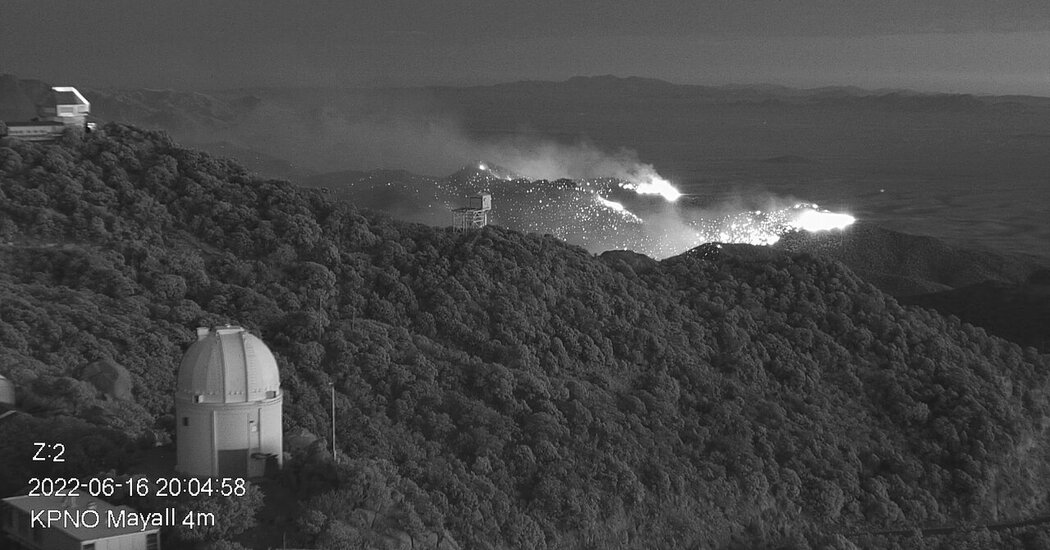Arizona Wildfire Destroys Observatory Buildings

[ad_1]
Astronomers watched in fear over the past week as a growing wildfire crept up an Arizona mountainside toward the Kitt Peak National Observatory, forcing 40 people to evacuate days before the blaze destroyed four buildings early Friday morning.
The fire, known as the Contreras fire, has scorched more than 18,000 acres, twisting among Indigenous-populated areas in the state near Tucson, and scientists might not be able to return to the observatory for weeks. But its telescopes, which number in the dozens, remained safe as of Sunday afternoon, officials said, and only the four buildings, which were not used for research, were destroyed.
Firefighters have contained 40 percent of the fire’s perimeter despite the excessive Southwest heat wave slowing their efforts, and, since the fire had not caused extensive damage to the area, the Indigenous community of Pan Tak, which had evacuated, was preparing to return. Fire crews will continue to patrol the area.
Although the fire has crested, and the threat to the observatory appears to have decreased, the close call represents a new facet of climate disasters: the endangerment of science and research.
Dr. David Schlegel, an astrophysicist in a research group that relies on Kitt Peak’s cutting-edge Mayall Telescope, said that more extensive fire damage, which might still be discovered among the technological equipment, could “pause the progression of cosmology for years to come.”
The fire, which was ignited by a lightning strike, already amounted to a significant disruption for the scientists and the residents in the surrounding community.
“Instead of doing work this past week, for the most part, it’s like being in a war — you’re completely distracted by what’s happening,” Dr. Schlegel said. He added that everyone knew about the fire for days before it crested but that “there’s absolutely nothing you can do.”
Kitt Peak, located in the Tohono O’odham Nation, was the first astronomical observatory in the United States funded by the National Science Foundation, and it is recognized across the globe as a landmark in astronomy, Dr. Schlegel said.
Dr. Schlegel works in the Dark Energy Spectroscopic Instrument program, which has used the observatory to map the universe by orders of magnitude. Simply assembling the technology required some 600,000 custom-ordered parts, he said.
Before the fire could reach the scientific structures, firefighters cleared flammable materials around them, as a form of protection. But exposure to high heat might have affected the equipment in ways that were not immediately noticeable.
“Likely, there will be smoke damage or infiltration of dust into the telescope and instrument,” Dr. Schlegel said. But, he added, if any of that caused the observatory to stop operating for a few months, “that would be way preferable to having to start over.”
The buildings that were damaged were mainly dormitories where researchers and students would sleep after spending entire nights using telescopes and other equipment.
The communities in the area are not in the clear, although they are close, said Dr. Michelle Edwards, associate director of the observatory. She visited the observatory on Saturday, accompanied by firefighting teams in protective gear.
Dr. Edwards said she observed “scattered fire across the top of the summit” and damage to the road leading up to the mountain, as well as to the observatory’s electrical systems. Scientists may not be able to return for at least six weeks unless a major change in weather, such as a thunderstorm, helps quash the fire, she said. The 10-day forecast for Kitt Peak includes chances of rain starting Tuesday, according to the National Weather Service.
The observatory has remained closed to the public since the start of the pandemic out of respect for the Tohono O’odham tribe’s social-gathering policies. The Nation scaled back those precautions on June 1, and Dr. Edwards had begun to plan the observatory’s reopening. Now, that is “set much farther back,” she said.
Dr. Evgenya Shkolnik, an associate professor of astrophysics at the School of Earth and Space Exploration at Arizona State University, said that her students conduct research at the observatory and that losing access to it would hit them hard.
When the telescopes are threatened, “our work is threatened,” Dr. Shkolnik said. “But, also, it can be very emotional. We also have wonderful memories there. We’ve trained our students there, trained ourselves and made great discoveries. We have personal and emotional attachments to our telescopes.”
[ad_2]




